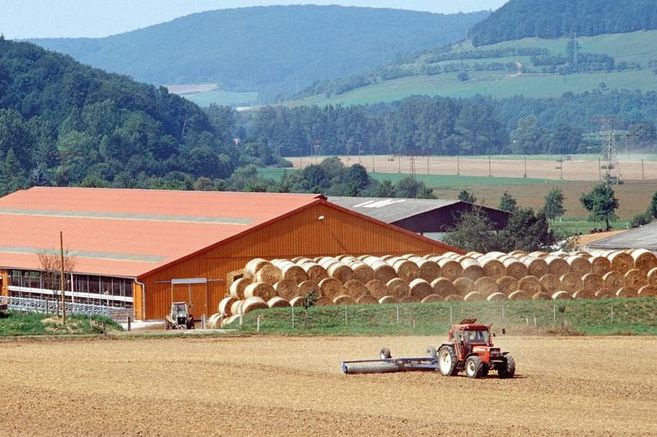Project
Structural change and competitiveness of the German horticultural sector
![[Translate to English:]](/media/_processed_/d/d/csm_1469_Gemuese_2021_600-dpi_groesser_3000_2b83ca41f7.png)
Analysis of the structure and competitiveness of the German horticultural sector
The structures of horticultural production in Germany are changing. Fewer farms cultivate, on average, more acreage and partially with very specialized crops. The intensity is influenced by different framework conditions such as legal and economic constraints as well as potentials.
Background and Objective
To date, systematically prepared and regularly updated information which would enable the analysis of status quo and development potentials of the German horticultural sector is lacking. Our aim is to analyse the structure and the competitiveness of horticultural production activities in Germany. We compare the competitiveness among German production regions and with main international competitors.
Approach
We regularly evaluate available statistics to show changes in the structure of horticultural production. In addition, we analyse how changes, e.g., of the legal framework, impact the sector. The establishment of an international scientific network to analyse horticultural production systems (agri benchmark Horticulture) helps to identify the competitive environment, as well as strengths, weaknesses, potentials and risks of the German horticultural sector.
Data and Methods
We interpret official data such as the agricultural census and specific production statistics. Furthermore, in the research network agri benchmark Horticulture, we establish typical horticultural farms to analyse horticultural production systems at the national and international level.
Preliminary Results
First, we conducted different studies to create a data basis on:
1. Profitability and productivity of horticulture in Germany,
2. Analysis of the German horticulture sector and of international trade with horticultural products,
3. Structure of the German horticultural sector,
4. governmental influences on horticulture in Germany,
5. Development of the demand for horticultural products and services.
The results of these studies were integrated into the BMEL Future Congress on Horticulture in the years 2009 and 2013.
The first steps for the establishment of agri benchmark Horticulture were taken in 2011. In the framework of an EU funded project, we could establish typical farms for the apple and wine grape production in Germany, France, Italy, Switzerland, Spain, Australia, Chile and South Africa. First results analysing the production systems and costs show that apple production in Chile is highly profitable in contrast to the other countries in the sample. Regarding wine, in many countries total costs of wine grape production are not covered. Further, in both crops, revenues alternate intensively in the different production regions between years. The reasons for this are perceptible fluctuations in yield and price levels.
Thünen-Contact

Involved Thünen-Partners
Duration
Permanent task 1.2008 - 12.2025
More Information
Project status:
ongoing
Publications to the project
- 0
Garming H, Hansen H, Weber E-C (2025) Auswirkungen steigender Löhne. Spargel & Erdbeer-Profi(4):27-29
- 1
Garming H, Hansen H, Weber E-C (2025) Auswirkungen steigender Löhne. Gartenbauprofi 112(9):49-51
- 2
Garming H (2025) How does production of organic vegetables meet the market demand in Germany? Acta Hortic 1416:493-499, DOI:10.17660/ActaHortic.2025.1416.63
- 3
Garming H (2025) Produktion und Nachfrage von Ökogemüse. Gemüse 61(11):61-63
- 4
Garming H (2025) Steckbriefe zum Gartenbau in Deutschland : Gemüsebau [online]. Braunschweig: Thünen-Institut für Betriebswirtschaft, 13 p, zu finden in <https://www.thuenen.de/media/ti-themenfelder/Pflanzenproduktion/Gartenbau/2025-10-29_Steckbrief_Gemuesebau.pdf> [zitiert am 18.11.2025]
- 5
Garming H (2025) Steckbriefe zum Gartenbau in Deutschland : Obst - Überblick [online]. Braunschweig: Thünen-Institut für Betriebswirtschaft, 8 p, zu finden in <https://www.thuenen.de/media/ti-themenfelder/Pflanzenproduktion/Gartenbau/20250728__Steckbrief_Obstbau.pdf> [zitiert am 18.11.2025]
- 6
Garming H (2025) Steckbriefe zum Gartenbau in Deutschland : Obstbau - Apfel [online]. Braunschweig: Thünen-Institut für Betriebswirtschaft, 9 p, zu finden in <https://www.thuenen.de/media/ti-themenfelder/Pflanzenproduktion/Gartenbau/20250728_Steckbrief_Obstbau_Apfel.pdf> [zitiert am 18.11.2025]
- 7
Garming H (2025) Steckbriefe zum Gartenbau in Deutschland : Obstbau - Erdbeeren [online]. Braunschweig: Thünen-Institut für Betriebswirtschaft, 8 p, zu finden in <https://www.thuenen.de/media/ti-themenfelder/Pflanzenproduktion/Gartenbau/20250728_Steckbrief_Obstbau_Erdbeeren.pdf> [zitiert am 18.11.2025]
- 8
Dirksmeyer W, Garming H, Kretzschmann A, Ludwig-Ohm S, Muder A, Luer R, Hermann A, Yoon J-K (2024) Chancen und Risiken des Obst- und Gemüsebaus in Deutschland : Situationsanalyse des Obst- und Gemüsesektors in Deutschland, auf der Grundlage einer Stellungnahme für das Bundesministerium für Ernährung und Landwirtschaft (BMEL) von Juni 2023. Berlin: BMEL, 101 p, Ber Landwirtsch SH 240, DOI:10.12767/buel.vi240.527
- 9
Garming H (2024) Steckbriefe zum Gartenbau in Deutschland: Gemüsebau. Braunschweig: Thünen-Institut für Betriebswirtschaft, 12 p
- 10
Garming H (2024) Steckbriefe zum Gartenbau in Deutschland: Obst - Überblick. Braunschweig: Thünen-Institut für Betriebswirtschaft, 7 p
- 11
Garming H (2024) Steckbriefe zum Gartenbau in Deutschland: Obstbau - Apfel. Braunschweig: Thünen-Institut für Betriebswirtschaft, 8 p
- 12
Garming H (2024) Steckbriefe zum Gartenbau in Deutschland: Obstbau - Erdbeeren. Braunschweig: Thünen-Institut für Betriebswirtschaft, 8 p
- 13
Garming H (2023) Steckbriefe zum Gartenbau in Deutschland : Gemüsebau. Braunschweig: Thünen-Institut für Betriebswirtschaft, 15 p
- 14
Garming H (2023) Steckbriefe zum Gartenbau in Deutschland : Obstbau. Braunschweig: Thünen-Institut für Betriebswirtschaft, 10 p
- 15
Garming H (2023) Steckbriefe zum Gartenbau in Deutschland : Obstbau - Apfel. Braunschweig: Thünen-Institut für Betriebswirtschaft, 11 p
- 16
Garming H (2023) Steckbriefe zum Gartenbau in Deutschland : Obstbau - Erdbeeren. Braunschweig: Thünen-Institut für Betriebswirtschaft, 10 p
- 17
Garming H (2022) Steckbriefe zum Gartenbau in Deutschland : Gemüsebau [online]. Braunschweig: Thünen-Institut für Betriebswirtschaft, 12 p, zu finden in <https://www.thuenen.de/media/ti-themenfelder/Pflanzenproduktion/Gartenbau/2022-11-21_Steckbrief_Gemuesebau.pdf> [zitiert am 29.11.2022]
- 18
Garming H (2022) Steckbriefe zum Gartenbau in Deutschland : Obstbau - Apfel [online]. Braunschweig: Thünen-Institut für Betriebswirtschaft, 9 p, zu finden in <https://www.thuenen.de/media/ti-themenfelder/Pflanzenproduktion/Gartenbau/2022-11-21_Steckbrief_Obstbau-Apfel.pdf> [zitiert am 29.11.2022]
- 19
Garming H (2022) Steckbriefe zum Gartenbau in Deutschland : Obstbau - Überblick [online]. Braunschweig: Thünen-Institut für Betriebswirtschaft, 8 p, zu finden in <https://www.thuenen.de/media/ti-themenfelder/Pflanzenproduktion/Gartenbau/2022-11-21_Steckbrief_Obstbau.pdf> [zitiert am 29.11.2022]
- 20
Behr HC, Dirksmeyer W (2019) Wo landet unser Obst? : Warenstromanalyse für Tafelobst. Obstbau(5):198-200
- 21
Garming H, Dirksmeyer W, Bork L (2018) Entwicklungen des Obstbaus in Deutschland von 2005 bis 2017. Agra Europe (Bonn) 59(41):D1-53
- 22
Garming H, Dirksmeyer W, Bork L (2018) Entwicklungen des Obstbaus in Deutschland von 2005 bis 2017: Obstarten, Anbauregionen, Betriebsstrukturen und Handel. Braunschweig: Johann Heinrich von Thünen-Institut, 139 p, Thünen Working Paper 100, DOI:10.3220/WP1531805739000
- 23
Garming H (2018) Zahlen und Fakten rund um Obstbau und -handel : Teil 1: Erdbeeren. Obstbau(10):570-572
- 24
Garming H (2018) Zahlen und Fakten rund um Obstbau und -handel : Teil 2: Baumobst. Obstbau(11):616-618
- 25
Garming H (2018) Zahlen und Fakten rund um Obstbau und -handel : Teil 3: Beerenobst. Obstbau(12):686-688
- 26
Dirksmeyer W, Garming H, Klockgether K (2017) Chancen durch Vielfalt. Agrarmanager(1):10-13
- 27
Klockgether K (2017) Länderporträt Gemüseproduktion Teil 7 - Neue deutsche Bundesländer : Gemüsebau in Brandenburg, Sachsen-Anhalt, Sachsen. Gemüse 53(1):54-55
- 28
Gallardo K, Garming H (2017) The economics of apple production. Burleigh Dodds Ser Agric Sci 18:485-510
- 29
Dirksmeyer W, Garming H, Strohm K (2016) Die Wettbewerbsfähigkeit des deutschen Obstbaues im internationalen Vergleich - das Netzwerk agri benchmark Horticulture. In: 41. Bundessteinobstseminar : Ahrweiler 29.11. bis 03. Dezember 2015 / [Hrsg.: Dienstleistungszentrum Ländlicher Raum (DLR) Rheinpfalz, Gruppe: Kompetenzzentrum Gartenbau (KoGa)]. Rheinbach: DLR, pp 87-95
- 30
Strohm K, Garming H, Dirksmeyer W (2016) Entwicklung des Gemüsebaus in Deutschland von 2000 bis 2015: Anbauregionen, Betriebsstrukturen und Handel - Auszüge des Thünen Working Papers 56. Agra Europe (Bonn) 57(24):D1-27
- 31
Strohm K, Garming H, Dirksmeyer W (2016) Entwicklung des Gemüsebaus in Deutschland von 2000 bis 2015: Anbauregionen, Betriebsstrukturen, Gemüsearten und Handel. Braunschweig: Johann Heinrich von Thünen-Institut, 151 p, Thünen Working Paper 56, DOI:10.3220/WP1461137491000
- 32
Klockgether K (2016) Länderporträt Gemüseproduktion Teil 1 - Einführung : Gemüsebau in Deutschland - eine Analyse. Gemüse 52(7):46-47
- 33
Klockgether K (2016) Länderporträt Gemüseproduktion Teil 2 - Pfalz und Hessen : Effiziente Strukturen sichern eine tragfähige Zukunft. Gemüse 52(8):52-53
- 34
Klockgether K (2016) Länderporträt Gemüseproduktion Teil 3 - Nordrhein-Westfalen : Gemüsebau nahe des größten Ballungsgebiets Deutschlands. Gemüse 52(9):50-51
- 35
Klockgether K (2016) Länderporträt Gemüseproduktion Teil 4 - Niedersachsen : Niedersachsen – Mehr als Spargel und Salat. Gemüse 52(10):42-43
- 36
Klockgether K (2016) Länderporträt Gemüseproduktion Teil 5 - Baden-Württemberg : Auf in den Süden zu Feldsalat, Zuckermais, Kürbis und Co.. Gemüse 52(11):50-51
- 37
Klockgether K (2016) Länderporträt Gemüseproduktion Teil 6 - Bayern : In der Heimat der Einlegegurken. Gemüse 52(12):42-43
- 38
Klockgether K, Garming H, Dirksmeyer W (2016) Strukturen und Strukturwandel im deutschen Freilandgemüsebau. Thünen Rep 44:113-133
- 39
Dirksmeyer W, Theuvsen L, Kayser M (eds) (2015) Aktuelle Forschung in der Gartenbauökonomie : Tagungsband zum 1. Symposium für Ökonomie im Gartenbau am 27. November 2013 in der Paulinerkirche Göttingen. Braunschweig: Johann Heinrich von Thünen-Institut, 340 p, Thünen Rep 22, DOI:10.3220/REP_22_2015
- 40
Fluck K, Dirksmeyer W (2015) Analysis of the economic importance of the German horticultural cluster. Acta Hortic 1099:533-539
- 41
Menghi A, Roest K de, Porcelluzzi A, Deblitz C, Davier Z von, Wildegger B, Witte T de, Strohm K, Garming H, Dirksmeyer W, Zimmer Y, Bölling D, van Huylenbroek G, Mettepenningen E (2015) Assessing farmers' cost of compliance with EU legislation in the fields of environment, animal welfare and food safety. Bruxelles: European Commission
- 42
Garming H, Dirksmeyer W (2015) Obstbau 2020 : der deutsche Obstbau im Wandel. Obstbau(7):402-407
- 43
Strohm K (2015) Speisezwiebelanbau in Deutschland : die wichtigsten Anbauregionen. Gartenbauprofi(2 = SH Zwiebel):19-21
- 44
Garming H, Dirksmeyer W, Strohm K (2015) Wirtschaftlichkeit der Apfelproduktion in Deutschland und Italien. Thünen Rep 22:129-147
- 45
Strohm K (2014) Carrots: Global overview and production structure in Germany. Hort Rep 2014:52-56
- 46
Strohm K, Dirksmeyer W, Garming H (2014) International Analysis of the Profitability of Wine Grape Production [online]. In: 8th International Conference Academy of Wine Business Research, Hochschule Geisenheim, June 28th - 30th, 2014, Geisenheim, Germany. pp 1-12, zu finden in <http://academyofwinebusiness.com/wp-content/uploads/2014/07/BM04_Dirksmeyer_Walter.pdf> [zitiert am 30.09.2014]
- 47
Strohm K, Dirksmeyer W, Garming H (2014) International analysis of the profitability of wine grape production [online]. DGG Proc Short Comm 4(1):1-5, zu finden in <http://www.dgg-online.org/proceedings/vol-04-2014/dgg-pr-04-01-ks-2014.pdf> [zitiert am 12.12.2014]
- 48
Garming H, Bravin E (2014) Netzwerk agri benchmark - Vergleich der Agrarproduktion im internationalen Kontext. Agrarforsch Schweiz 5(1):32-35
- 49
Garming H (2014) Results agri benchmark Horticulture : 2.1 ; Apple results. Hort Rep 2014:9-17
- 50
Strohm K (2014) Results agri benchmark Horticulture : 2.2 ; Wine grape results. Hort Rep 2014:18-26
- 51
Garming H, Bravin E (2014) Wo lohnt es sich Äpfel zu produzieren? Obst Weinbau 150(6):12-15
- 52
Schreiner M, Altmann M, Stenger M, Korn M, Dirksmeyer W, Ludwig-Ohm S, Gossen U, Graf J (2014) Zukunftsstrategie Gartenbau : Abschlussbericht zum Zukunftskongress Gartenbau am 11./12. September 2013 in Berlin [online]. Bonn: Bundesministerium für Ernährung und Landwirtschaft (BMEL), 84 p, zu finden in <http://www.bmel.de/SharedDocs/Downloads/Landwirtschaft/Pflanze/Gartenbau/ZukunftsstrategieGartenbauBerichtKongress2013.pdf?__blob=publicationFile> [zitiert am 17.02.2014]
- 53
Ludwig-Ohm S, Dirksmeyer W (2013) Ausgewählte Analysen zu den Rahmenbedingungen und zur Wettbewerbsfähigkeit des Gartenbaus in Deutschland. Braunschweig: Johann Heinrich von Thünen-Institut, 290 p, Thünen Working Paper 6, DOI:10.3220/WP_6_2013
https://literatur.thuenen.de/digbib_extern/bitv/dn052167.pdf
- 54
Schreiner M, Altmann M, Stenger M, Korn M, Dirksmeyer W, Ludwig-Ohm S, Gossen U, Graf J (2013) Bericht der Forschergruppe zum Zukunftskongress Gartenbau : 10. und 11. September 2013. Bonn: BMELV, 73 p
- 55
Ludwig-Ohm S, Dirksmeyer W (2013) Kooperationen und Wertschöpfungsketten im Gartenbau: Ergebnisse eines Workshops. Thünen Working Paper 6:217-245
- 56
Dirksmeyer W, Garming H, Ludwig-Ohm S (2013) Situation des Gartenbaus in Deutschland sowie Möglichkeiten und Hemmnisse für seine zukünftige Entwicklung: Ergebnisse einer Befragung von Beratern und Berufsstand. Thünen Working Paper 6:9-45
- 57
Ludwig-Ohm S, Dirksmeyer W (2013) Zur Wettbewerbsfähigkeit des Gemüsebaus in Deutschland. DGG Proc Short Comm 3(14):1-5, DOI:10.5288/dgg-pr-03-14-sl-2013
- 58
Ludwig-Ohm S, Dirksmeyer W (2012) Ausbildung im Gartenbau – eine Situationsanalyse. TASPO(4):8
- 59
Dirksmeyer W (2012) Perspektiven des deutschen Gartenbaus. Obstbau(3):175-176
- 60
Dirksmeyer W (2012) Structural change in fruit and vegetable production in Germany. In: Proceedings of the XXVIII International Congress on Science and Horticulture for People, Proceedings of the International Symposium in Integrating Consumers and Economic Systems, IHC 2010, Acta Horticulturae, 930. pp 91-97
- 61
Dirksmeyer W, Kerstjens KH (2009) Ausbildung im Produktionsgartenbau. Landbauforsch SH 330:169-181
https://literatur.thuenen.de/digbib_extern/bitv/dk042509.pdf
- 62
Dirksmeyer W (2009) Betriebsstrukturen im Produktionsgartenbau. Landbauforsch SH 330:3-42
https://literatur.thuenen.de/digbib_extern/bitv/dk042499.pdf
- 63
Dirksmeyer W, Sourell H, Lübbe E (2009) Einfluss des Klimawandels auf den Beregnungsbedarf. TASPO 143(21):8
- 64
Dirksmeyer W (2009) Exkurs: Beratungsstrukturen im Produktionsgartenbau. Landbauforsch SH 330:163-167
https://literatur.thuenen.de/digbib_extern/bitv/dk042508.pdf








